NIL
Lady Spartans sweep Vikettes 5-2, 6-1 in WaMaC Softball Tourney – Solon Economist
SOLON — Sighs of relief swell over the diamond as the late inning attempted comeback is squandered with a fly out. Cheers erupt from the Solon stands. Victory music sings as the Lady Spartans take the field to celebrate their doubleheader victories against the Vinton-Shellsburg Vikings. Game One Through the fourth inning, few had been […]
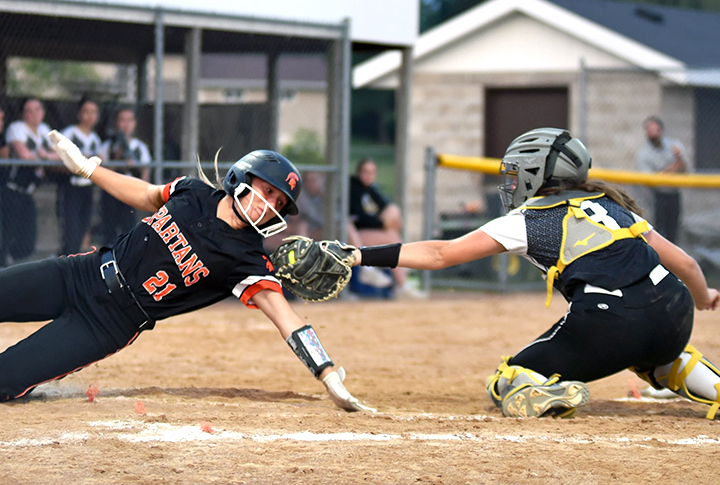
SOLON — Sighs of relief swell over the diamond as the late inning attempted comeback is squandered with a fly out. Cheers erupt from the Solon stands. Victory music sings as the Lady Spartans take the field to celebrate their doubleheader victories against the Vinton-Shellsburg Vikings.
Game One
Through the fourth inning, few had been on base and the score was tied at nil. Early hits from the likes of Dillon Ostrander, Laeni Hinkle, and Keegan Kleppe were forgotten when factoring in the Vikings stellar defense.
“It took a while for our offense to get going,” said Spartan head coach Brad Holub. “We were just under everything and popped up a lot of them but, of all the pitchers we’ve faced this year, she [Vikings pitcher] probably gave us the most trouble.”
As the top of the fifth progressed, the Spartans were trailing. One fielding mishap let to another, allowing for Vinton-Shellsburg to hit their way around the diamond, bringing the score to 0-2.
When pitcher Beckitt Kabela, keeping her composure and focus, struck the last Viking out swinging in the fifth, the tension was loosened and you could both hear, and feel, the determination from the Spartans.
“Come on Spartans, let’s do this!” Yelled one Solon parent, followed by an array of motivational applause.
That may have been just the motivation that the Spartans needed as they came out swinging in the bottom of the fifth. A single to left field from Beckett Kruse got the crowd on its feet and opened the flood gates. A successful bunt from Kleppe, a single from Hinkle, and a long double to center from shortstop Izzy Frees followed, scoring three runs to end the inning, putting the Spartans in the lead.
Hinkle came into the game as a reliever and kept the Vikings at bay for the rest of the game. A few more hits and a masterclass of base stealing from Kruse, Kleppe, and Dillon Ostrander put this game in the past, beating Vinton-Shellsburg 5-2.
Game Two
After what felt like an offensive lull in the beginning of game one, the Spartans came out swinging right off the bat in the second game, scoring two in the first, three in the third, and one in the fourth.
The big story of the second game was its lone home run from first baseman Addison Walter in the first at bat of the fourth inning, making it her first of her career. The ball was smacked toward center, hitting the top of the fence and bouncing right over, leaving her teammates jumping for joy around home plate.
“It was great to see,” said Holub, commenting on Walter’s home run. “She really barreled one up and it paid dividends, so I felt really good for her.”
From that point on in game two, there was no stopping the Spartans as they went on to maintain their large lead through a defensive performance. Pitcher Emerson Miller threw the entirety of game two, putting on a show and allowing only one score through seven innings.
“We knew it was going to be a challenge… we messed with the line up a little bit, you know trying to look at matchups and not overusing somebody, but I thought our pitching did really well as a whole tonight,” said Holub.
Final score: 6-1
NIL
College sports has a soft salary cap now. How does it work?
FILE – The national office of the NCAA in Indianapolis is shown on March 12, 2020. (AP Photo/Michael Conroy, File) AP College sports has another before and after date. Before July 1, 2025 — last Tuesday — athletes could make money off their name, image and likeness (NIL) but not be paid directly by their […]
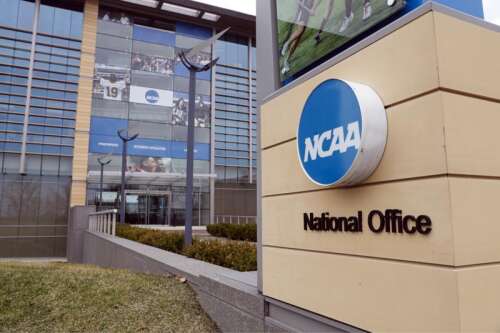
FILE – The national office of the NCAA in Indianapolis is shown on March 12, 2020. (AP Photo/Michael Conroy, File)
AP
College sports has another before and after date.
Before July 1, 2025 — last Tuesday — athletes could make money off their name, image and likeness (NIL) but not be paid directly by their schools. And after July 1, that has changed, making college sports look and feel even more like the pros.
Some of the long-standing differences and caveats still apply. College athletes are not considered employees. Therefore, unlike athletes in the NFL, the NBA, the WNBA, the NHL and MLB, their pay and working conditions were not established through a collective bargaining process. But at least one major change will be familiar to any fan of those professional leagues.
College sports has a (soft) salary cap now. Let’s unpack.
How did this come about?
At the most practical level, the soft salary cap (or revenue sharing cap) is part of the massive legal settlement approved in early June. Commonly referred to as the House settlement, it consolidated three antitrust cases, all of them challenging past restrictions of college athlete compensation. And in that process, the defendants — the NCAA and the power conferences — agreed to allow schools to share revenue with (or pay) athletes directly for the first time. That officially started Tuesday.
Lawyers for the defendants and plaintiffs settled on an initial annual cap of $20.5 million per school. That is for athletes across sports, though a bulk of the money will go to salaries for football and men’s basketball players. Not every school will spend to the cap, though many power conference programs will. More than 300 Division I schools have opted into the new economic model, meaning they can pay athletes — up to that cap — but also have to abide by new roster limits in each sport. Schools that chose not to opt in are not allowed to pay athletes through revenue sharing. For now, this cap explainer is not relevant to them.
Why $20.5 million?
The starting cap was calculated by taking 22% of the average athletic revenue for power conference schools. In this case, the figures were from the 2023 and 2024 fiscal years. Importantly, only a specific set of revenue streams was considered, which has the attention of the plaintiffs’ attorneys for House. Each year, the settlement will require the NCAA to share the data used to calculate the cap with the plaintiffs’ attorneys. From there, the settlement permits the attorneys to “reasonably audit” the data — and this week, Steve Berman, one of the lead attorneys, told USA Today they are doing just that. In question is whether certain revenue streams were not counted and should be, which could increase the initial number.
Berman told USA Today that he is fine with going ahead with $20.5 million for 2025-26. But if the number were recalculated in an auditing process …
That would be significant. Why?
Great question. Perfect time to ask.
The settlement is a 10-year agreement. The cap will rise and recalculate throughout that span. There will be a 4% bump before the second, third, fifth, sixth, eighth and ninth years. There will be a recalculation, using that same 22% formula, before the fourth, seventh and 10th years. So if the baseline changed because of an immediate audit of the $20.5 million figure, there could be a trickle-down (or trickle-up?) effect on the initial annual increases.
What counts as spending toward the cap?
Three streams: revenue-sharing money paid to athletes, which will essentially function as salaries; scholarship spending above previous NCAA limits; and other education-related payments, known as Alston money.
Alston money can account for up to $2.5 million per year toward the cap. Same with scholarship spending, though that part is a bit trickier to explain. The settlement permits schools to pay an uncapped amount of scholarship money to a fixed number of athletes across sports. Or in other words: Previous limits on scholarship spending have been replaced by new roster limits, meaning more money distributed to fewer athletes. A football team, for example, can carry a maximum of 105 players and offer 105 full scholarships, if it so chooses. But as far as the $20.5 million cap is concerned, only scholarship money spent above previous NCAA limits — and only up to $2.5 million per year — will count toward it. Confused? Welcome to the life of a longtime college compliance staffer.
Why have you repeatedly referred to this as a soft cap?
Another great question.
Until this point — before July 1, 2025 — boosters funded five-, six- and seven-figure salaries in football, men’s basketball and, to a lesser extent, women’s basketball and other sports. With rules established by the settlement, the NCAA and the power conferences hope to change that. Any NIL deal that exceeds $600 will have to go through a clearinghouse, which will trigger a review of who is paying and what services they will receive from the athlete, among other factors. The hope, for the leaders of college sports, is to eliminate situations in which an athlete receives $500,000 for a few social media posts.
At the highest levels of the biggest sports, those deals have fueled the NIL economy for the past four years. Donor groups, known as NIL collectives, typically have brokered them. Many legal experts are skeptical that the enforcement efforts would hold up against more antitrust suits.
And throughout the history of college sports, there’s at least one certainty: Motivated rich people will find a way to help their teams win. For that reason — that donors and NIL collectives will help schools spend above the $20.5 million barrier — it feels most responsible to call it a soft cap. The whole system could put at least some athlete payments back under the table, such as when they used to be delivered in McDonald’s bags before the NCAA changed its NIL rules in 2021. Plus, beyond donor money, schools and collectives can still help athletes land brand deals to enhance their income.
At the top of college football and basketball, spending from the revenue-sharing pool will be viewed as a baseline. It will, as ever, take a lot more money to thrive.
FILE – In this photo taken with a slow shutter speed, Wichita State’s Ron Baker runs during practice for the NCAA college basketball tournament, March 20, 2014, in St. Louis. (AP Photo/Charlie Riedel, file)
AP
NIL
A Candid Conversation with The Most Interesting Man in the SEC
Shiyazh Pete was a coveted offensive tackle in the transfer portal. His decision to commit to Kentucky on the final day of the winter transfer window was met with fanfare. When Pete first arrived in Lexington, we quickly learned there’s much more to the man behind the facemask. A giant among giants, Pete towers over […]

Shiyazh Pete was a coveted offensive tackle in the transfer portal. His decision to commit to Kentucky on the final day of the winter transfer window was met with fanfare. When Pete first arrived in Lexington, we quickly learned there’s much more to the man behind the facemask.
A giant among giants, Pete towers over his peers at 6-foot-8, 322 pounds. It’s not the only thing that sets him apart.
In the spring, the Kentucky newcomers were introduced to the media. Pete’s prose is unlike his predecessors. That was clear when he was asked about his offensive line coach, Eric Wolford.
“He lives up to his name, the Wolf,” said Pete. “He’s cunning, he’s keen, he’s pretty sharp. I like that about him.”
My first thought after hearing that: “I need to spend more time talking to that guy?” That’s exactly what Kentucky Sports Radio did ahead of the July Fourth holiday weekend.
Pete has impressive credentials as an All-Conference left tackle for a 10-win team at New Mexico State, arguably the best in that program’s history. While most fans will be focused on how well he stacks up against SEC opponents, that’s just a fraction of what he’s bringing to the Big Blue Wall.
He grew up as a self-proclaimed nerd in Montana. The son of a Captain in the U.S. Army, he spent his formative years living in the Navajo Nation. He is Diné, which translates to “the people.” Pete proudly wears his braid while adding new hobbies. Pete can quickly complete a Rubik’s Cube and dabbles in the didgeridoo. This curious cat learns new about new topics, typically by watching a movie, then dives in headfirst. That is why we spent five minutes talking about Napoleon Bonaparte.
Pete went from playing on a high school football team with 11 players to one of the worst programs in the FBS, one that eventually played the role of David and slayed Goliath at Jordan-Hare Stadium. Ahead of his final college football season, he’s grateful for the opportunity to showcase his skills in the SEC. What does he envision in his final college football performance?
“Napoleon.”
Enjoy this candid conversation before Shiyazh Pete conquers the SEC at Kentucky.
More Kentucky News and Views on the KSR YouTube Channel
Kentucky Sports Radio has expanded its coverage of the Wildcats in the most ridiculous manner possible on our YouTube Channel. Here you will be able to find interviews with coaches and players, as well as commentary from the KSR crew. From Rapid Reactions following big events to our lengthy lineup of live shows, subscribe to the KSR YouTube Channel to stay up to date on everything happening around the Big Blue Nation.
NIL
Texas Tech Lands 5-Star Felix Ojo With $5.1M NIL Deal, Beating Out Texas, Ohio State
Texas Tech secured five-star offensive tackle Felix Ojo on July 4 with a record-breaking $5.1 million NIL contract that made headlines across college football. The Red Raiders pulled off one of the biggest recruiting coups in program history by landing the nation’s No. 5 overall prospect and top offensive tackle, defeating powerhouse programs including Texas, […]

Texas Tech secured five-star offensive tackle Felix Ojo on July 4 with a record-breaking $5.1 million NIL contract that made headlines across college football.
The Red Raiders pulled off one of the biggest recruiting coups in program history by landing the nation’s No. 5 overall prospect and top offensive tackle, defeating powerhouse programs including Texas, Ohio State, Michigan, and Florida.

Texas Tech Lands Five-Star Recruit with Record NIL Deal
Social media exploded when On3 Sports broke the news on Twitter, announcing that the 6’7″, 285-pound tackle from Mansfield Lake Ridge High School had inked the largest fully guaranteed NIL revenue-share agreement in college football history.
REPORT: 5-star OT Felix Ojo has inked a fully-guaranteed 3-year, $5.1 million revenue share deal with Texas Tech, per ESPN
https://t.co/IuLmz74erK https://t.co/EG5cDYOIkD pic.twitter.com/cBuev5Q5Oh
— On3 (@On3sports) July 4, 2025
According to his agent, the three-year deal worth $5.1 million features a significant escalator structure. Year one pays $1.2 million, year two reaches $1.6 million, and year three peaks at $2.1 million. This groundbreaking contract came just days after the federal settlement legalizing direct revenue-share payments took effect on July 1.
Rough breakdown of Felix Ojo’s deal includes a significant escalator, per his agent @Derrick__Shelby:
Year 1 – $1.2 million
Year 2 – $1.6 million
Year 3 – $2.1 million https://t.co/rgweK3oYmp https://t.co/HU76KhYQDm— Pete Nakos (@PeteNakos_) July 4, 2025
The timing proves crucial for Texas Tech’s aggressive NIL strategy, which already paid dividends after the program invested over $10 million in transfer portal additions in early 2025. The Matador Club’s willingness to offer seven-figure deals across multiple sports established the Red Raiders as serious players in the new NIL landscape.
Historic Commitment Transforms Red Raiders Recruiting
Ojo’s commitment represented a massive upset as he selected Texas Tech over his final four schools. The Longhorns and Buckeyes were considered co-favorites throughout the process, making his decision even more surprising for college football analysts.
The elite prospect ranks as the No. 5 overall player in the 2026 class according to 247Sports Composite, while ESPN rates him No. 4 in their ESPN 300. His commitment makes him the highest-rated signee in Texas Tech program history, surpassing previous recruiting milestones for the Big 12 program.
Ojo’s addition transforms the Red Raiders’ 2026 recruiting class, with the latest available rankings showing a major jump but not universally to 23rd nationally or 1st in the Big 12. Some sources have Texas Tech ranked as high as 23rd and 1st in the Big 12, while others show a current rank of 29th nationally and 1st in the Big 12. The class average rating improvement reflects the significant talent upgrade that comes with landing a five-star prospect.
Beyond recruiting rankings, the impact extends to on-field performance expectations. Research shows each five-star recruit contributes approximately 0.306 additional wins per season, making Ojo’s presence valuable for Texas Tech’s competitive outlook. His position at left tackle will dramatically improve pass protection and create better opportunities for the running game under Coach Joey McGuire’s offensive system.
The signing establishes Texas Tech’s commitment to competing at the highest level in college football while setting new benchmarks for NIL deals across the sport. College football programs nationwide are watching how this unprecedented contract structure influences future recruiting battles and player compensation models.
Ojo is expected to arrive on campus in the summer of 2026 and immediately compete for a starting role on the offensive line. His presence should provide immediate impact for a program looking to establish itself as a consistent Big 12 contender under McGuire’s leadership.
NIL
Report
Mansfield (TX) Lake Ridge five-star offensive tackle Felix Ojo, one of the top prospects in 2026, made a Fourth of July commitment to Texas Tech. The Red Raiders will now be paying him quite well with an unprecendented, fully guaranteed revenue-sharing deal. Ojo committed to Texas Tech this afternoon over top schools like Texas, Oklahoma, Michigan, Ohio […]


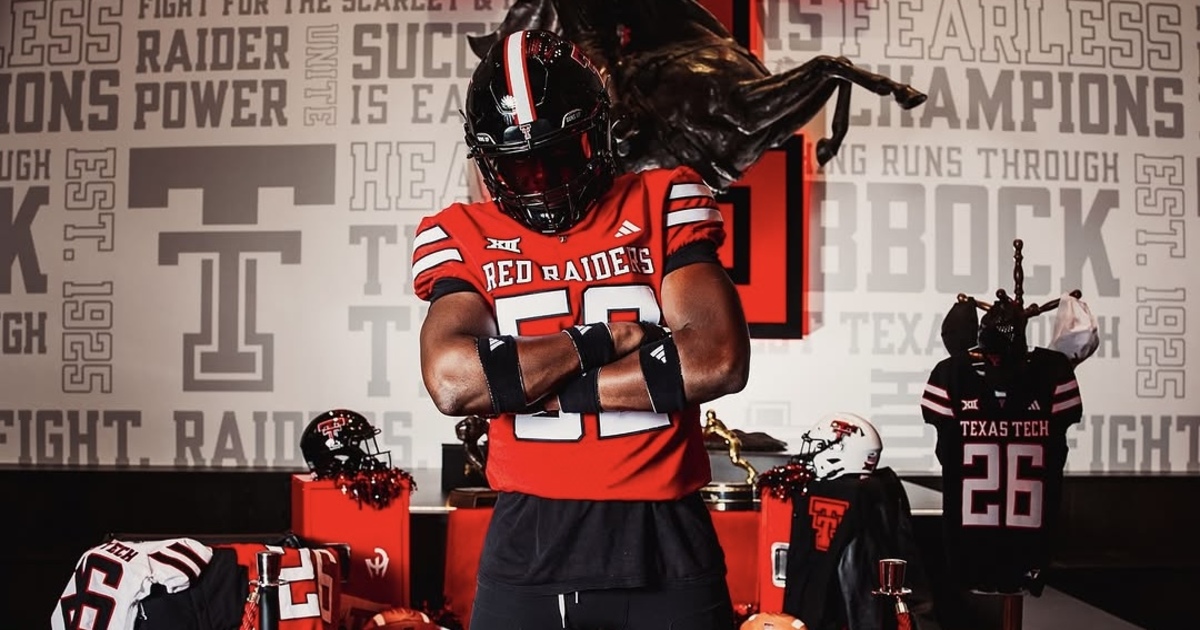
Mansfield (TX) Lake Ridge five-star offensive tackle Felix Ojo, one of the top prospects in 2026, made a Fourth of July commitment to Texas Tech. The Red Raiders will now be paying him quite well with an unprecendented, fully guaranteed revenue-sharing deal.
Ojo committed to Texas Tech this afternoon over top schools like Texas, Oklahoma, Michigan, Ohio State, and Ole Miss. ESPN’s Eli Lederman reported that the Red Raiders signed Ojo to a fully guaranteed revenue-share deal worth $5.1 million over three years. On3’s Pete Nakos reported more details of the agreement.
Ojo’s guaranteed rev-share amount is roughly half the $5.1 million, according to Nakos, and the contract pays out $775,000 per year over three years. Including incentives and if the deal is renegotiated, the five-star offensive lineman is set to earn $1.2 million in Year 1, $1.6 million in Year 2 and $2.1 million in Year 3. Nakos added Texas Tech softball helped pull the deal off.
This comes a few days after the House v. NCAA settlement took effect around college athletics. Judge Claudia Wilken approved the settlement back on June 6th after nearly five years since the filing of House v. NCAA. That allowed for revenue-sharing, with schools paying athletes directly, beginning earlier this week on July 1st.
Ojo ranks as the No. 6 overall recruit as a five-star prospect in the 2026 cycle. He also rates as the No. 3 OT in the class, behind Jackson Cantwell (No. 1 – Miami) and Immanuel Iheanacho (No. 4 – Oregon). He is also the No. 1 player in the state of Texas, according to the On3 Industry Ranking, a weighted average that utilizes all four major recruiting media companies. Following his July 4th commitment, Ojo becomes Texas Tech’s highest-rated commitment of all time as part of what’s shaping out to be a Top-25 class for the Red Raiders in 2026.
This comes after the spring where Texas Tech became a national player in the NIL and transfer portal landscape. The Red Raiders are coming off of an 8-5 2024 season in Year 3 for head coach Joey McGuire, who signed the No. 1 class in the NCAA Transfer Portal, according to On3. Eight of their 21 portal additions this offseason ranked in the Top-100 of On3’s 2025 Top Transfer Portal Players. Expectations are now becoming more real for the program down in the Big 12, especially if they can capitalize on this season after recruiting success both in the portal and in high school.
For today, though, Texas Tech can enjoy what is the commitment of their highest-ranked recruit in school history. Ojo can celebrate as well with his recruitment ending in what’s reportedly a very large, guaranteed deal for him ahead of his collegiate career in Lubbock.
NIL
Texas Tech Signs 5-Star Felix Ojo in $5M NIL Deal
Share Tweet Share Share Email Felix Ojo, a consensus five-star offensive tackle ranked among the top prospects nationally in the 2026 class, committed to Texas Tech on July 4th over heavyweights like Texas, Ohio State, Florida, and Michigan. The standout from Mansfield, Texas, has reportedly landed a fully guaranteed revenue-sharing contract valued at $5.1 million […]
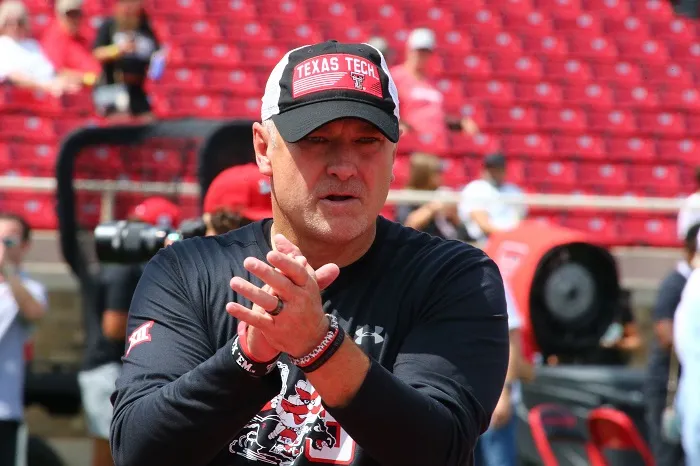
Felix Ojo, a consensus five-star offensive tackle ranked among the top prospects nationally in the 2026 class, committed to Texas Tech on July 4th over heavyweights like Texas, Ohio State, Florida, and Michigan.
The standout from Mansfield, Texas, has reportedly landed a fully guaranteed revenue-sharing contract valued at $5.1 million over three years—a deal believed to be among the most lucrative in college football history, per ESPN’s Eli Lederman.
The NIL agreement includes a structured payout that escalates over the term—beginning at approximately $1.2 million in Year One and growing to about $2.1 million in Year Three, per On3’s Pete Nakos.
At 6-foot-7 and 285 pounds, Ojo brings pro-level size and upside to Lubbock, where he becomes the highest-rated recruit in program history. He arrives as the second-ranked tackle and top in-state prospect in Texas for 2026, according to composite rankings that place him among the nation’s top-five overall recruits.
Texas Tech’s aggressive NIL strategy has paid off again, helping fuel their climb in recruiting rankings and strengthen a roster already bolstered by a top-tier portal class this past off-season.
The Red Raiders are now ranked in the Top 25 in the country in the 247Sports 2026 Class rankings. Texas Tech also jumped BYU for the top spot in the Big 12 Conference.

NIL
STUNNER
Texas Tech secured five-star offensive tackle Felix Ojo on July 4 with a record-breaking $5.1 million NIL contract that made headlines across college football. The Red Raiders pulled off one of the biggest recruiting coups in program history by landing the nation’s No. 5 overall prospect and top offensive tackle, defeating powerhouse programs including Texas, […]


Texas Tech secured five-star offensive tackle Felix Ojo on July 4 with a record-breaking $5.1 million NIL contract that made headlines across college football.
The Red Raiders pulled off one of the biggest recruiting coups in program history by landing the nation’s No. 5 overall prospect and top offensive tackle, defeating powerhouse programs including Texas, Ohio State, Michigan, and Florida.

Texas Tech Lands Five-Star Recruit with Record NIL Deal
Social media exploded when On3 Sports broke the news on Twitter, announcing that the 6’7″, 285-pound tackle from Mansfield Lake Ridge High School had inked the largest fully guaranteed NIL revenue-share agreement in college football history.
REPORT: 5-star OT Felix Ojo has inked a fully-guaranteed 3-year, $5.1 million revenue share deal with Texas Tech, per ESPN
https://t.co/IuLmz74erK https://t.co/EG5cDYOIkD pic.twitter.com/cBuev5Q5Oh
— On3 (@On3sports) July 4, 2025
According to his agent, the three-year deal worth $5.1 million features a significant escalator structure. Year one pays $1.2 million, year two reaches $1.6 million, and year three peaks at $2.1 million. This groundbreaking contract came just days after the federal settlement legalizing direct revenue-share payments took effect on July 1.
Rough breakdown of Felix Ojo’s deal includes a significant escalator, per his agent @Derrick__Shelby:
Year 1 – $1.2 million
Year 2 – $1.6 million
Year 3 – $2.1 million https://t.co/rgweK3oYmp https://t.co/HU76KhYQDm— Pete Nakos (@PeteNakos_) July 4, 2025
The timing proves crucial for Texas Tech’s aggressive NIL strategy, which already paid dividends after the program invested over $10 million in transfer portal additions in early 2025. The Matador Club’s willingness to offer seven-figure deals across multiple sports established the Red Raiders as serious players in the new NIL landscape.
Historic Commitment Transforms Red Raiders Recruiting
Ojo’s commitment represented a massive upset as he selected Texas Tech over his final four schools. The Longhorns and Buckeyes were considered co-favorites throughout the process, making his decision even more surprising for college football analysts.
The elite prospect ranks as the No. 5 overall player in the 2026 class according to 247Sports Composite, while ESPN rates him No. 4 in their ESPN 300. His commitment makes him the highest-rated signee in Texas Tech program history, surpassing previous recruiting milestones for the Big 12 program.
Ojo’s addition transforms the Red Raiders’ 2026 recruiting class, with the latest available rankings showing a major jump but not universally to 23rd nationally or 1st in the Big 12. Some sources have Texas Tech ranked as high as 23rd and 1st in the Big 12, while others show a current rank of 29th nationally and 1st in the Big 12. The class average rating improvement reflects the significant talent upgrade that comes with landing a five-star prospect.
Beyond recruiting rankings, the impact extends to on-field performance expectations. Research shows each five-star recruit contributes approximately 0.306 additional wins per season, making Ojo’s presence valuable for Texas Tech’s competitive outlook. His position at left tackle will dramatically improve pass protection and create better opportunities for the running game under Coach Joey McGuire’s offensive system.
The signing establishes Texas Tech’s commitment to competing at the highest level in college football while setting new benchmarks for NIL deals across the sport. College football programs nationwide are watching how this unprecedented contract structure influences future recruiting battles and player compensation models.
Ojo is expected to arrive on campus in the summer of 2026 and immediately compete for a starting role on the offensive line. His presence should provide immediate impact for a program looking to establish itself as a consistent Big 12 contender under McGuire’s leadership.
-

 Health3 weeks ago
Health3 weeks agoGymnast MyKayla Skinner Claims Simone Biles 'Belittled and Ostracized' Her amid Riley …
-

 Motorsports3 weeks ago
Motorsports3 weeks agoNASCAR Race Today: Mexico City start times, schedule and how to watch live on TV
-

 Motorsports3 weeks ago
Motorsports3 weeks agoNASCAR in Mexico City: Where to watch, start time, stream, lineup, race preview for inaugural Viva Mexico 250
-

 College Sports1 week ago
College Sports1 week agoWAC to Rebrand to UAC, Add Five New Members in 2026
-

 High School Sports3 weeks ago
High School Sports3 weeks agoNew Bedford top stories
-

 College Sports3 weeks ago
College Sports3 weeks agoLivvy Dunne honors boyfriend Paul Skenes with twist on LSU jersey
-

 Health3 weeks ago
Health3 weeks agoKyrie Irving's Strong Message Amid Men's Mental Health Awareness Month
-

 Technology2 weeks ago
Technology2 weeks agoPolar is teasing a Whoop alternative without subscription
-
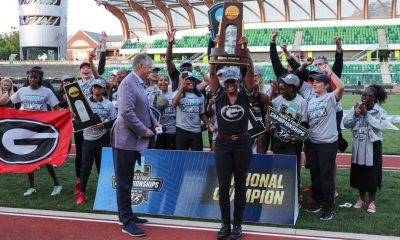
 Sports3 weeks ago
Sports3 weeks agoGeorgia women soar to first outdoor track championship
-

 Motorsports3 weeks ago
Motorsports3 weeks agoParker Kligerman Mourns Loss of NASCAR Team Owner in Moving Tribute











 (via dukedennis/TT)
(via dukedennis/TT)

























